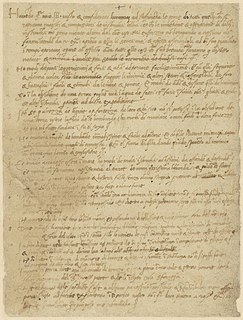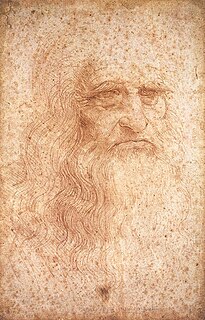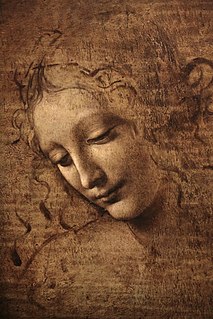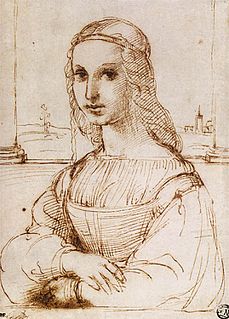
Leonardo da Vinci was an Italian polymath of the High Renaissance who was active as a painter, draughtsman, theorist, engineer, scientist, sculptor and architect. While his fame initially rested on his achievements as a painter, he also became known for his notebooks, in which he made drawings and notes on a variety of subjects, including anatomy, astronomy, botany, cartography, painting, and paleontology. Leonardo's genius epitomized the Renaissance humanist ideal, and his collective works compose a contribution to later generations of artists rivaled only by that of his younger contemporary and fellow founder of the High Renaissance, Michelangelo.

The Mona Lisa is a half-length portrait painting by Italian artist Leonardo da Vinci. Considered an archetypal masterpiece of the Italian Renaissance, it has been described as "the best known, the most visited, the most written about, the most sung about, the most parodied work of art in the world". The painting's novel qualities include the subject's enigmatic expression, the monumentality of the composition, the subtle modelling of forms, and the atmospheric illusionism.

The Last Supper is a late 15th-century mural painting by Italian artist Leonardo da Vinci housed by the refectory of the Convent of Santa Maria delle Grazie in Milan, Italy. It is one of the Western world's most recognizable paintings.

Ginevra de' Benci is a portrait painting by Leonardo da Vinci of the 15th-century Florentine aristocrat Ginevra de' Benci. The oil-on-wood portrait was acquired by the National Gallery of Art in Washington, D.C. in 1967. The sum of US$5 million—an absolute record price at the time—came from the Ailsa Mellon Bruce Fund and was paid to the Princely Family of Liechtenstein. It is the only painting by Leonardo on public view in the Americas.

Francesco Melzi, or Francesco de Melzi (1491–1570), was an Italian painter born into a family of the Milanese nobility in Lombardy. He was one of Leonardo da Vinci’s pupils.

The Lady with an Ermine is a portrait painting widely attributed to the Italian Renaissance artist Leonardo da Vinci. Dated to c. 1489–1491, the work is painted in oils on a panel of walnut wood. Its subject is Cecilia Gallerani, a mistress of Ludovico Sforza, Duke of Milan; Leonardo was painter to the Sforza court at the time of its execution. It is one of only four surviving portraits of women painted by Leonardo, the others being Ginevra de' Benci, La Belle Ferronnière and the Mona Lisa.

The Portrait of a Musician is an unfinished painting widely attributed to the Italian Renaissance artist Leonardo da Vinci, dated to c. 1483–1487. Produced while Leonardo was in Milan, the work is painted in oils, and perhaps tempera, on a small panel of walnut wood. It is his only known male portrait painting, and the identity of its sitter has been closely debated among scholars.

Saint John the Baptist is a High Renaissance oil painting on walnut wood by Leonardo da Vinci. Likely completed between 1513 to 1516, it is believed to be his final painting. The original size of the painting was 69 by 57 centimetres. It is now exhibited at the Musée du Louvre in Paris, France.

The Isleworth Mona Lisa is an early sixteenth-century oil on canvas painting depicting the same subject as Leonardo da Vinci's Mona Lisa, though with the subject depicted as being a younger age. The painting is thought to have been brought from Italy to England in the 1780s, and came into public view in 1913 when the English connoisseur Hugh Blaker acquired it from a manor house in Somerset, where it was thought to have been hanging for over a century. Since the 1910s, experts in various fields, as well as the collectors who have acquired ownership of the painting, have asserted that the major elements of the painting are the work of Leonardo himself, as an earlier version of the Mona Lisa.

Giovanni Antonio Boltraffio was an Italian painter of the High Renaissance from Lombardy, who worked in the studio of Leonardo da Vinci. Boltraffio and Bernardino Luini are the strongest artistic personalities to emerge from Leonardo's studio. According to Giorgio Vasari, he was of an aristocratic family and was born in Milan.

The Italian polymath Leonardo da Vinci (1452–1519) left thousands of pages of writings and drawings, but rarely made any references to his personal life. The resulting uncertainty, combined with mythologized anecdotes from his lifetime, has resulted in much speculation and interest in Leonardo's personal life. Particularly, his personal relationships, sexuality, philosophy, religion, vegetarianism, left-handedness and appearance.

The 16th-century portrait Mona Lisa, or La Gioconda, painted in oil on a poplar panel by Leonardo da Vinci, has been the subject of a considerable deal of speculation.

La Bella Principessa, also known as Portrait of Bianca Sforza, Young Girl in Profile in Renaissance Dress and Portrait of a Young Fiancée, is a portrait in coloured chalks and ink, on vellum, of a young lady in fashionable costume and hairstyle of a Milanese of the 1490s. Some scholars have attributed it to Leonardo da Vinci but the attribution and the work's authenticity have been disputed.

The portrait of a man in red chalk in the Royal Library of Turin is widely, though not universally, accepted as a self-portrait of Leonardo da Vinci. It is thought that Leonardo da Vinci drew this self-portrait at about the age of 60. The portrait has been extensively reproduced and has become an iconic representation of Leonardo as a polymath or "Renaissance Man". Despite this, some historians and scholars disagree as to the true identity of the sitter.

La Scapigliata is an unfinished painting generally attributed to the Italian High Renaissance artist Leonardo da Vinci, and dated c. 1506–8. Painted in oil, umber and white lead pigments on a small poplar wood panel, its attribution remains controversial, with several experts attributing the work to a student of Leonardo. The painting has been admired for its captivating beauty, mysterious demeanor, and mastery of sfumato.

Salvator Mundi is a painting attributed in whole or in part to the Italian High Renaissance artist Leonardo da Vinci, dated to c. 1499–1510. Long thought to be a copy of a lost original veiled with overpainting, it was rediscovered, restored, and included in Luke Syson's major Leonardo exhibition at the National Gallery, London, in 2011–12. Christie's claimed just after selling the work that most leading scholars consider it to be an original work by Leonardo, but this attribution has been disputed by other specialists, some of whom posit that he only contributed certain elements.
Carmen C. Bambach (1959) is an American art historian and curator of Italian and Spanish drawings at the New York Metropolitan Museum of Art who specializes in Italian Renaissance art. She is considered one of the world's leading specialists on Leonardo da Vinci, especially his drawings.

The two-Mona Lisa theory is a longstanding theory proposed by various historians, art experts, and others that Leonardo da Vinci painted two versions of the Mona Lisa. Several of these experts have further concluded that examination of historical documents indicates that one version was painted several years before the second.
Luke Syson is an English museum curator and art historian. Since 2019, he has been the director of the Fitzwilliam Museum at the University of Cambridge, prior to which he held positions at the British Museum (1991–2002), the Victoria and Albert Museum (2002–2003), the National Gallery (2003–2012) and the Metropolitan Museum of Art (2015–2019). In 2011 he curated the highly acclaimed Leonardo da Vinci exhibition at the National Gallery: Leonardo da Vinci: Painter at the Court of Milan. That same year, he played a pivotal role in the controversial authentication of the Salvator Mundi, which remains disputed.
















